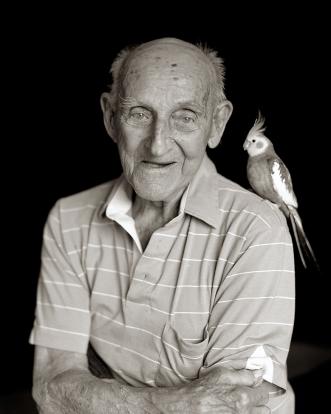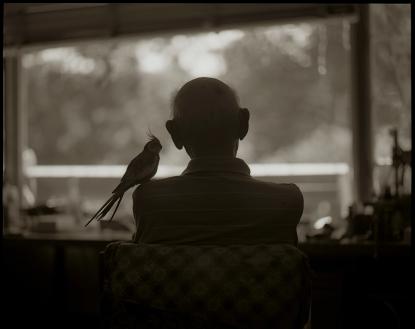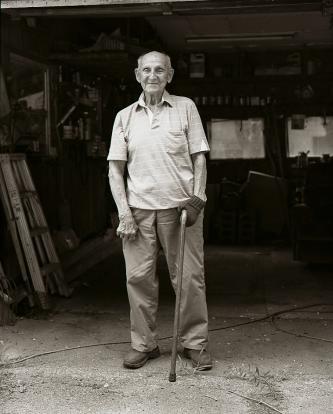
Joe and his parakeet Susie,photographed with natural light in an upstairs bedroom of Joe’s house in Ipswich.
The North Shore of Boston is a biological sanctuary. Salt marshes, tidal creeks and estuaries comprise thousands of acres of this pristine coastal landscape. Ipswich, one of the 17 towns that make up the North Shore, is known for one thing more than any other: its clams. But that’s not all Ipswich is known for, at least according to one man. Ask Joe Laudarowicz about sea worms. He became a legend because of them.
Born in Ipswich on July 4, 1910, Joe is one of seven children of Polish immigrants who migrated to the United States during the industrial revolution. He attended grammar school through the 5th grade, and then set off to dig clams. Clamming was a good profession then. The muddy tidal flats in Ipswich produced one of the sweetest, sought after “crops” in the region – steamers, aka soft shell clams. They were plentiful and easy to get as long as the digger had a strong back and some simple tools. Two tides a day, unlimited digging.
By the time Joe was 19 he had saved enough money to buy a piece of land across the road from Ipswich River where gradually he built his family’s house. It was right around that time Joe was introduced to the art of digging sea worms. Something clicked, and for Joe, there was no turning back.
I liked clamming but I loved my worms. I was known as “the worm guy.” I was the only one who knew how to take care of the worms. I experimented and little by little I learned just what I needed to do. Everybody around here said they couldn’t get over it. They said when they bought worms, usually they just died. But you have to take care of them. You have to spread them out and take the moisture off of them. Everyone bought my worms.
Joe ran a small bait and tackle shop out of his basement where he sold worms to local fisherman and packed them up to ship throughout New England. His special preservation techniques and love for the worms earned him quite a reputation.
Years ago when Unger started photographing clammers, one of her Ipswich clamming buddies said, “You need to photograph Joe the worm guy…. Now that’s a face, and he’s got the stories to go with it”. So she scribbled his name down on a scrap piece of paper and shoved it in a folder labeled, “clamming.” Over the years she’d periodically see that scrap piece of paper as she was shuffling through the file, and think, “someday maybe I’ll meet this worm guy”. It wasn’t until last year when she drove up the dirt driveway to the house and was sitting at his kitchen table that she realized this is Joe the Worm Guy. Finally she could put a face to the legend!

Joe sits at his worktable with his pet parakeet, Susie and looks out the window to his front yard.
His pink house sits back off the road, a paved thoroughfare connecting the town center with the main route to Boston. A large picture window looks out over the bird feeders and whirligigs that adorn his front yard. Beneath the inside window is a large work table, where Joe often sits watching the birds peck away at the feeders as he makes whirligigs from the remnants of his bait and tackle shop.
Next week he will celebrate his 101st birthday in the house he’s lived in since building it, in 1929.
Stories like Joe’s are the focus of a new book called People and Place: Oral Histories and Portraits of Ipswich Seniors and will be published this fall. This art and history book includes 30 edited oral histories and corresponding fine art portraits of Ipswich residents over the age of 80 who have spent the majority of their lives in Ipswich.
Co-authors, Lucy Myers (English teacher) and Terri Unger (photographer) have organized the project around the central topic of people and place within an historical framework. Specifically, the authors explore themes central to Americans during the early to mid 20th century such as work, ethnicity, education, immigration and the pursuit of the American Dream. The generation of Americans born at this time experienced World War II and the Great Depression. How did the individuals of this small New England town respond to those events? What opportunities did Ipswich provide for new comers? What is their relationship with the landscape?
A main goal of the project is to facilitate communication among different groups and individuals in Ipswich, particularly between the older and younger generations. Myers and Unger have hosted several public events to accomplish this, most recently a collaboration with the Ipswich Middle School 8th graders and seniors in the book. The students interviewed the seniors about their experiences with the Crane Beach picnic day, an Ipswich tradition, and wrote essays which appeared in the local newspaper.
A final exhibition of the work will be displayed at the Ipswich Museum this fall (2011) to correspond with the release of the book. All thirty portraits and excerpts from the text will be on display. A generous grant from Mass Humanities has allowed the authors to interview and photograph the 30 participants and host the community events and final exhibition. Additional sponsorship from the Coburn Charitable Trust, EBSCO Publishing, Massachusetts Cultural Council and individuals has furthered project goals.
To learn more about the People and Place Project or to make a contribution visit the website at: PeopleAndPlaceProject.com.

Joe in his garage doorway after he mowed his lawn


